Liam and the Flosaraphtor
When I was learning to drive, my father used to sneak out to our beige '67 Volkswagen and put a folded dollar bill in the receiving end of the seat belt. It was like a little reward for buckling up, and it worked. The whole system fell apart when my brother figured it out and raided the seat belt for date money.
In this age of plug-in fun, where most kids' favorite places to play are near an outlet, I like to emulate my father. Maybe it's Cheezits and chocolate as a surprise in a backpack, or a monarch caterpillar of your very own to feed, watch, and wonder at.
But I digress. Back to the mystery claw...There was only one thing to do about it. We knew just who to turn to: to our friend Boneman, an artist who re-imagines and reconstructs extinct creatures for a living. And who also has a Boston terrier pup from Chet's breeder. Coincidence? I do not think so.
Dear Mr. Mohn,
what the heck is this? i saw a video all about dinosaurs. And i saw a flosaraphtors tooth/claw And it looks just like a tooth. Don't know what it is. And i found it in a stream (near where we live in Ohio) under a flat rock. Thank you!
- Liam
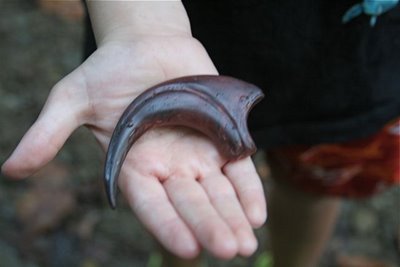 this is me finding it....
this is me finding it....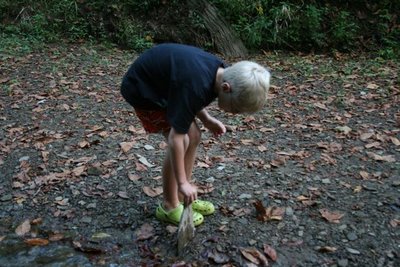 and this is me showing it to Margret.
and this is me showing it to Margret.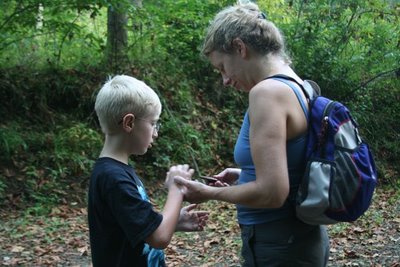 Hi Liam:
Hi Liam:Now that really is a mystery! As far as I know, the fossil bearing matrix in Ohio is millions of years older than the oldest known dromaeosaur (droh-meh-o-sahr) fossil (the dinosaur family to which the Mongolian species Velociraptor and the North American species, Deinonychus (dy-non-ick-us) belong to).
That certainly looks like a dromaeosaur claw though. It may be that it is what paleontologists call an erratic fossil. Erratics are fossils that have been transported beyond the place where the original animal died, was buried and became fossilized. There are various agents of transport, ranging from animals that may pick something up and carry it for some distance to landslides, floods, glaciers and continental drift. I live in southeastern NJ, which is relatively young in geological terms, having been formed within the last million years and we really don't have any rocks that formed here and so no really old fossils. But I do occasionally find fossils of very ancient cup corals and crinoids which were transported from upstate New York by glaciers and rivers and then deposited here.
Dromaeosaurs are currently known from Western North America, Mongolia, China and South America. There are some other fossils which may be dromaeosaurs that have been found on other continents, but these are very fragmentary remains, just a few bones, which makes it hard to make a positive identification. The oldest known specimens are about 120 million years old, though there are some indications that they may have first appeared about 160 million years ago. Some dromaeosaur species survived until the end of the age of dinosaurs, about 65 million years ago.
Your claw appears to look like and be about the right size as those of the North American species, Deinonychus, which is known from Montana and a few other Western states. Deinonychus means terrible claw. You may have seen the movie Jurassic Park, which featured an animal that the movie's paleontologist called Velociraptor. As you may know, sometimes Hollywood plays fast and loose with the truth. The real Velociraptor is nowhere near as tall as the Jurassic Park raptors. Specimens have been found that are seven feet long, but only about three and a half feet tall and quite slender. The JP raptors are closer in size and shape to Deinonychus. There are specimens of Deinonychus that were four and half feet tall and nearly twelve feet long. There are other dromaeosaur species which appear to have been far larger. Utahraptor, which is only known from a few scattered bones, may have been twenty five feet long and six to eight feet high.
You've made a really neat find! I hope you enjoy it and that you continue to investigate the mystery of how it came to be in Ohio!
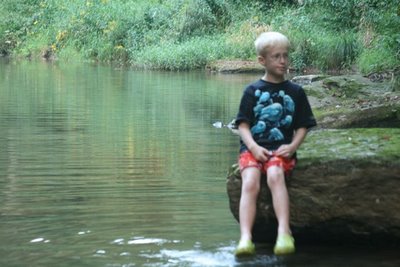
I can assure you that he enjoys it, Mr. Mohn.
It will be a puzzle, and an inspiration, for years to come.
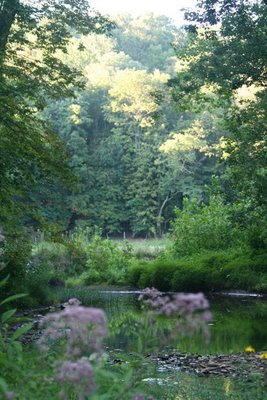 There is mystery beneath still waters, outside where so many children now rarely go. In the muck and the gravel, something wonderful may wait.
There is mystery beneath still waters, outside where so many children now rarely go. In the muck and the gravel, something wonderful may wait.Many thanks to Bruce Mohn for his knowledge, expertise and skill.
Labels: Deinonychus claw, dromaeosaurs, erratic fossils, Velociraptor





